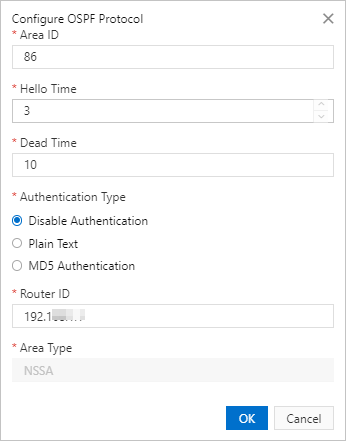Smart Access Gateway (SAG) supports the Open Shortest Path First (OSPF) protocol.
This topic describes how to configure OSPF routing for an SAG device in the SAG console.
Prerequisites
An SAG-1000 device is used.
Background information
OSPF uses a link state routing (LSR) algorithm, falls into the group of interior gateway
protocols (IGPs), and operates within a single autonomous system. OSPF automatically
establishes a link state database and generates a shortest path tree based on the
status of network ports. Each OSPF router uses these shortest path trees to construct
a routing table, which implements fast convergence of the routing table and reduces
network latency.
If your local network structure is constantly changing and networks are frequently
added or deleted, we recommend that you use OSPF. OSPF dynamically adjusts routing
based on your network changes and reduces network latency. You do not need to manually
modify routing configurations. This allows you to manage and maintain your networks
in a more efficient way.
Procedure
- Log on to the Smart Access Gateway console.
- Choose one of the following methods to open the Device Management tab.
- Click the ID of the target SAG instance. On the instance details page that appears,
click Device Management.
- Find the target SAG instance. In the Actions column, choose .
- On the Device Management tab, click the Manage Routes tab.
- In the OSPF Protocol Settings section, click Edit.
- On the Configure OSPF Protocol page that appears, set the parameters as described in the following table.

| Parameter |
Description |
| Area ID |
The area ID. Valid values: 1 to 2147483647. |
| Hello Time |
The time interval at which hello packets are sent.
Valid values: 1 to 65535.
|
| Dead Time |
The dead time of the OSPF neighbor. If no hello packet is received within the specified
dead time, the OSPF neighbor is disconnected.
Valid values: 1 to 65535.
|
| Authentication Type |
Select one of the following authorization types:
- Disable Authentication: disables authentication.
- Plain Text: uses plaintext authentication. A plaintext password is required.
The password must be 1 to 8 characters in length, and can contain letters, digits,
hyphens (-), and underscores (_).
- MD5 Authentication: uses MD5 authentication. An MD5 key ID and an MD5 key are required.
Valid values of the MD5 key ID: 1 to 2147483647.
Valid values of the MD5 key: 1 to 47.
|
| Router ID |
The IP address of the router that has enabled OSPF. Enter an IPv4 address, for example,
192.168.1.1.
|
| Area Type |
Default value: NSSA. |
- In the WAN/LAN Dynamic Routing Settings section, select Enable OSPF Protocol.
- Find the target port and click Edit in the Actions column.
- On the Modify OSPF Dynamic Routing Settings page that appears, select whether to enable OSPS and click OK.
- Enable OSPF: enables OSPF for the target port.
- Disabled: disables OSPF for the target port.

